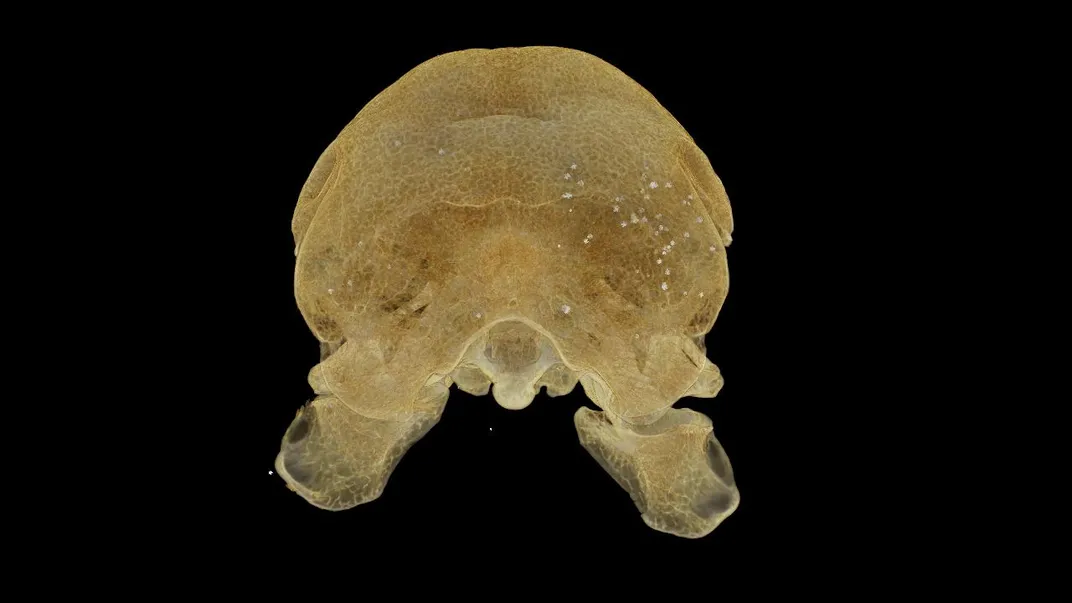Murder Most Fowl: Forensic Scan Shows the Legendary Oxford Dodo Was Shot
Micro-CT scans shows lead scattered across the back of the skull of what is believed to be the taxidermied remains of the dodo brought to Britain
/https://tf-cmsv2-smithsonianmag-media.s3.amazonaws.com/filer/68/2f/682f358e-8590-4298-a7a1-ba2e7e0526a1/dodo_mummy.jpg)
Almost everyone is familiar with the dodo, the 3-foot-tall, flightless, dumpy-looking bird whose name has been transformed into a playground insult.
But, surprisingly, despite its ubiquity in the popular culture, we don’t really don’t know too much about the bird. Sailors gobbled the chubby birds into extinction on their native Mauritius Island in the late 1600s, aided by invasive species like rats, cats and dogs. There are only about a dozen dodo skeletons in museums that remain. The mummified head and foot of a dodo at Oxford’s Natural History Museum is the only known surviving soft tissue. As the BBC reports, that particular specimen was believed to come from a living dodo that was once kept as a curiosity in London. But a new forensic scan shows the Oxford dodo was shot in the back of the head, raising the question: is it a case of mistaken identity, or was the bird... murdered?
Laura Geggel at LiveScience reports that DNA from the Oxford dodo was successfully sequenced in a 2002 study, revealing that the birds were related to pigeons. But the evolutionary adaptations and life history of the dodo remains somewhat hazy. So the researchers at the University of Oxford’s Museum of Natural History decided to take another look at the skull of the Oxford dodo, teaming with scientists from University of Warwick's Warwick Manufacturing Group to create a 3-D model of it using a cutting-edge micro-CT scan.
While they were taking the scan, they found that the dodo’s skull was covered with lead shot pellets. The bird, they realized, had been blasted from behind (thoguh notably, the pellets were not able to penetrate its thick skull). “When we were first asked to scan the Dodo, we were hoping to study its anatomy and shed some new light on how it existed,” University of Warwick professor Mark Williams says in a press release. “In our wildest dreams, we never expected to find what we did.”
The Museum of Natural History believed it knew the provenance of the Oxford dodo. Several live dodos were reportedly brought to Europe in the 1600s (many of them subsequently suffered from obesity, skewing our image of the dodo, but that’s another story). One of these dodos supposedly lived in London and is mentioned in a 1638 anecdote. After its death, the creature was taxidermied and then acquired by a London museum run by gardeners and naturalists John Tradescant the Elder and the Younger. The contents of their museum, including the remains of the once-living dodo, later went to Elias Ashmole, who founded Oxford’s Ashmolean Museum. But by 1775 when the remains were examined, they were found to be in bad shape, picked apart by feather mites. The head and the foot was salvaged and ultimately those pieces were transferred from the Ashmolean Museum to the Museum of Natural History. There Lewis Carroll, a frequent visitor, is said to have used the remains, in addition to the famed Jan Savery painting of the bird also on view at the museum, as inspiration while writing Alice's Adventures in Wonderland.

The shot to the head raises the question whether the Oxford dodo comes from the purported living dodo, or if it was one hunted in the wild. “There is now a mystery regarding how the specimen came to be in Tradescant's collection,” Paul Smith, the director of the Oxford University Museum of Natural History, tells Geggel.
It also begs the question: who killed the bird? In an interview with Nicola Davis at The Guardian Smith says there's no simple answer. “If it was the bird that was in London in 1638, why would anyone just shoot a dodo in London," he says. "And if it was [shot] in Mauritius, which is I suppose marginally more likely, there is a really serious question about how it was preserved and transported back, because they didn’t have many of the techniques that we use in the modern-day to preserve soft tissues – and we know it came back with its feathers and its skin intact.”
That being said, Williams tells Kas Roussy at CBC News that there are some clues that may aid researchers in tracking down the killer. “Having small lead pellets to shoot game fowl only started at almost the same time as the bird became extinct,” Williams said. “We could be looking at the first examples of lead shots ever used to hunt game birds.”
The next step in the forensic process is to do a chemical analysis of the lead shot, Smith tells Roussy, which may unearth some answers. “Using those analyses, we may be able to trace which particular ore field the lead came from, and therefore what country it was mined in, and potentially what country the shot was made in so that we could then determine who killed the dodo,” he says.
It’s very possible that the Oxford dodo was, in fact, dead as a dodo long before it ever made it to England. Henry Nicholls at The Guardian reports that there is little evidence that a living dodo ever made an appearance in London aside that single 1638 eye-witness account. Several academic articles also make the case that there is no tangible proof that a living dodo ever set a stubby wing in the city.